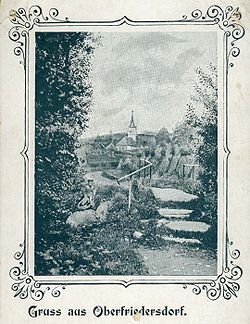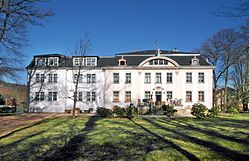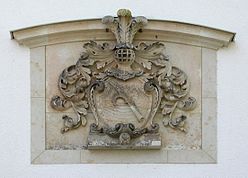Friedersdorf (Spree)
|
Friedersdorf
City of Neusalza-Spremberg
|
||
|---|---|---|
| Coordinates: 51 ° 1 '26 " N , 14 ° 33' 34" E | ||
| Height : | 345 m | |
| Area : | 10.89 km² | |
| Residents : | 1289 (December 31, 2011) | |
| Population density : | 118 inhabitants / km² | |
| Incorporation : | January 1, 2008 | |
| Postal code : | 02742 | |
| Area code : | 035872 | |
|
Location of Friedersdorf in Saxony |
||
Friedersdorf (Spree) is part of the municipality of the town of Neusalza-Spremberg in southeast Saxony near the border with the Czech Republic in the district of Görlitz .
Geography and traffic
The Friedersdorf district is located in the south-western part of the Görlitz district. It is located approx. 2 km northwest of Ebersbach / Sa. in the Lusatian highlands . The (Dresden-Stolpen-) Neusalza-Zittauer Landstrasse, today's B 96 , laid out between 1835 and 1836 , runs through the municipality and the border with the Czech Republic runs south of the town. The community is located on the Sohland – Ebersbach section of the Zittau – Dresden railway, which was opened on May 1, 1875 (see: Bischofswerda – Zittau railway ). The Spree flows through the village and, as its southern inlet, the Richterflössel . The Friedersdorfer Wald borders to the north and the Grenzwald to the south .
| Neusalza-Spremberg | Schönbach | Dürrhennersdorf |

|
||
| Šluknov | Ebersbach / Sa. |
Mountains and elevations
Several mountains line the Spree valley in which Friedersdorf is located:
- Buchberg (395.0 m),
- Steinberg (384.4 m),
- Wacheberg (384.8 m), with "Black Rock" (basalt dome),
- Ziegelberg (374.0 m).
history
Friedersdorf was first mentioned in a document on January 21, 1272. At that time with the names "Friderichstorf" "Vrederichstorp", "Vrederikistorp", named after a locator Friedrich, later (1360) "Friderichstorf", 1397 "Frydrychsdorf", 1408 "Fridrichsdorff", 1419 "Frederßdorf inferior", 1430 "Frederichsdorff", 1503 "Friderßdorff", 1567 "Oberfriederßdorff" and 1580 "Niderfridersdorf". Friedersdorf was laid out as a Waldhufendorf by the settlers along the Spree Valley in the course of the feudal German expansion to the east . In other words, the parcels (= forest hooves) were perpendicular to the Spreelauf in the direction of the forest. However, there are first settlements from the Bronze Age . Until the end of the 15th century around 1490 (division between 1489 and 1493) Friedersdorf was a place, then it was divided, and it was only reunified on April 1, 1938. The Gasthaus Grenzschänke from 1768 refers to the earlier dividing line. In the meantime, Oberfriedersdorf had belonged to the city of Zittau since 1597 , while Niederfriedersdorf was in noble hands. Friedersdorf was predominantly a farming village, with craftsmen added later and house weaving in the 17th century, but this trade was replaced by textile factories. In 1877 Hans Leo von Oppell acquired the Niederfriedersdorfer manor and had a new castle built as a mansion. The place became a village of factory workers, but not an industrial village. Smaller companies settled there, such as the paint factory, which produced school paints in GDR times, and a button factory.
The following administrative affiliation is to be named for Friedersdorf (Ober- and Niederfriedersdorf): 1777: Bautzener Kreis, 1843: Regional Court District Löbau, 1856: Judicial Office Neusalza, 1875: Amtshauptmannschaft Löbau , 1952: Landkreis Löbau , 1994: Landkreis Löbau-Zittau and from the 1. August 2008: District of Görlitz.
The originally independent community Friedersdorf (old four-digit postcode 8701, former districts Friedersdorf and Neufriedersdorf) became a district of Neusalza-Spremberg on January 1, 2008.
Oberfriedersdorf
In Oberfriedersdorf there had been a post office since April 16, 1898, and a telegraph company and public telephone station there since August 20, 1899. The districts Hempel and Viehbig belonged to the municipality of Oberfriedersdorf.
Oberfriedersdorf as a Waldhufendorf had an area of approx. 386 hectares in 1900.
The manor owned the Schluckenau manor (Bohemia) in 1567, and the Zittau council in 1597 and 1777.
In 1580 Oberfriedersdorf was parish after Spremberg. In October 1801 the construction of the parish church in Oberfriedersdorf was completed. From 1923 to 1937 it was under the Dürrhennersdorf branch church.
Forms of place names: The name Oberfriedersdorf was first mentioned in a document in 1561. It changed as follows: 1419: "Frederßdorff superior", 1567 "Oberfriederßdorff", 1657 "Ober Friedersdorff" and 1875 "Oberfriedersdorf, Zittauer and Schliebenscher Antheil", (formerly Mittelfriedersdorf).
Niederfriedersdorf
Niederfriedersdorf as a Waldhufendorf with districts had an area of approx. 704 hectares in 1900.
In 1777 the manor owned the Niederfriedersdorf manor.
Niederfriedersdorf was pastured to Spremberg in 1580 and belonged to the Friedersdorf parish from 1930-2001.
Forms of place names: The name Niederfriedersdorf is documented as early as 1519 and in the form "Nieder Dorf" even as early as 1493. It changed as follows: 1567 "Nieder-Friederßdorff", 1657 "Nieder Friedersdorff" and 1875 "Niederfriedersdorf".
Landlords and their owners
Until the end of the 15th century, the manor in Niederfriedersdorf belonged to the whole of Friedersdorf, from then on only the lower part with the Vorwerk , since 1690 again a part of the upper part.
Owner of the Niederfriedersdorf manor since 1392:
- 1392 first feudal men brothers Heinrich and Hans von Rawssendorf (Raussendorf) and Bernhard von Döbschicz
- 1408 Heinrich von Rawssendorf junior
- 1430 Hinrich Lotticze (Luttitz), as "village lord of Frederichsdorff"
- 1469–1655 von Rodewitz family
- 1469 Heinrich von Rodewitz ("sat on Friedersorf")
- 1489 his sons Christoph and Heinrich von Rodewitz
- 1503 Heinrich von Rodewitz as sole owner
- 1532 his six sons Bernhard, Heinrich, Caspar, Hans, Peter and Christoph von Rodewitz
- from 1592 as the sole owner Christoph "the elder" (at that time around 84 years old)
- 1598 his nephew Peter von Rodewitz "zue Spremberg" (who was in "total fiefdom" with his uncle) and his oath (?) Christoph von Gersdorf
- 1604 whose oath (?) Rudloff von Rodewitz (married to an Anna von Gersdorf)
- 1605 their son Caspar Heinrich von Rodewitz as a result of an inheritance contract (he was stabbed to death by Hans von Nostitz auf Krobnitz in Dehsa in 1614, Caspar Heinrich's brother Adam von Rodewitz was referred to as lord "on Spremberg and Friedersdorf" at the atonement in 1617)
- 1614 Rudloff von Rodewitz (a cousin of Caspar Heinrich von Rodewitz, who in 1630 sold his "Oberforbergk" to his oath "Landeskommissarius" Wolff Heinrich von Leubnitz, see below; in 1637 he appeared as "Erbherr")
- after 1637 his sons Caspar Christoph and Peter Abraham von Rodewitz, as their co-heirs probably also Wolff Heinrich von Leubnitz, husband of Martha von Rodewitz
- 1650 Christoph Volkmann von Gerßdorff, Hans Christoph von Nosticz and Oßwald Nizsche as believers, as late as 1655 they persistently refused to recognize the two brothers as owners towards the elector
-
1655–1843 Leubnitz family
- after 1655 and no later than 1657 Wolff Heinrich von Leubnitz mentioned above
- 1666 whose sons left behind, of whom
- 1667 Rudolph Abraham von Leubnitz was the sole owner
- 1689 his son Wolff Ernst von Leubnitz, state elder of Upper Lusatia, who bought part of Oberfriedersdorf in 1690 and the Vorwerk in Niederfriedersdorf in 1692 (see below)
- 1738 his son Gottlob August von Leubnitz, since 1749 provincial commissarius and since 1758 provincial elder of Upper Lusatia, in 1761 he transformed the fiefdom Friedersdorf into his own property
- 1774 his brother Carl Ludwig von Leubnitz, whose name bears the year 1785 of the poor house he founded in Niederfriedersdorf, (his wife was born von Schlieben, † 1782)
- 1783 his son Joh. Aug. Ludwig von Leubnitz
- 1828 his wife Auguste Sophie Friederike von Leubnitz, born von Polenz († 1845)
- 1845 their daughter Emilie Auguste von Leubnitz, married von Schlieben
- August 11, 1845 their son Hans Anton August von Schlieben
- December 8, 1874 Karl Friedrich Eduard Müller, bought the estate from the Schlieben heirs
- June 14, 1875 inherited the estate by his son Heinrich Eduard Müller
- July 14, 1877 Purchase of the property by Hans Leo von Oppell (* August 8, 1846 - July 19, 1915) and his wife Marie Louise Margarethe von Oppell (nee Freiin Dathe von Burgk) from Dresden
- from 1915 by Mrs. von Oppell, later with her eldest son Hans Adolf von Oppell
From 1880 onwards, extensive renovations and new buildings were made in the area of the estate:
- Orangery
- Servants' House (opposite the orangery)
- Workers' House (east of the manor)
- Stable systems
Population development
Until 1939
| Year / date | Residents | ||
| Oberfriedersdorf | Niederfriedersdorf | Neufriedersdorf | |
| 1777 | 92 cottagers , 9 gardeners, 17 especially men, 3 deserted areas |
54 cottagers, 16 gardeners, 11 especially men, 1 desert |
9 cottagers |
| 1834 | 979 | 803 | |
| 1871 | 1,286 | 919 | 104 |
| 1890 | 1,295 | 982 | 116 |
| 1910 (December 1st) | 1,354 | 1,051 | to Niederfriedersdorf |
| 1925 | 1,276 | 1,028 | |
| 1933 | together 2,281 |
From 1939
| Year / date | Residents |
|---|---|
| 1939 | 2.156 |
| 1946 | 2,574 |
| 1950 | 2,709 |
| 1964 | 2,373 |
| 1990 | 1,709 |
| 2000 | 1,590 |
| 2003 (December 31) | 1,527 |
| 2005 (December 31) | 1,445 |
politics
Friedersdorf has a local council. The mayor is Günter Hamisch. He is considered to be the intellectual originator of the cross-border association of German and Czech municipalities, which is known as the five-municipality . As the mayor of the then still independent municipality, he was co-signatory of the corresponding declaration of intent of the mayors of the five municipalities on May 18, 2002 on the Czech Jüttelberg near the border . Besides Friedersdorf, the mayors Günther Paulik ( Neusalza-Spremberg ) and Karl-Heinz David ( Oppach ) from the German side and Milan Kořínek ( Šluknov ) and Michal Maják ( Jiříkov ) from the Czech side signed the document as members. With the incorporation of Friedersdorf into Neusalza-Spremberg in 2008 and the inclusion of Sohland (Spree) under Mayor Matthias Pilz on May 10 of the same year, the gap in the five-community could be closed. On November 4, 2011, the twin town of Ebersbach-Neugersdorf joined the five -community community with mayor Verena Hergenröder.
coat of arms
Blazon : "Silver-gold divided by a blue wavy bar in the base of the shield, above an uprooted green spruce, flanked by two green ears with golden grains on leafy green stalks."
The coat of arms of the Friedersdorf district was registered and documented in the HEROLD's German coat of arms on December 10, 2012 as the coat of arms of a non-independent district with the registry "5 SN" . It was donated by the local council, represented by Günter Hamisch, in order to use it as a symbol of the local-local identity outside of official acts. The design was done by the municipal heraldist Jörg Mantzsch , who carried out the certification.
The symbolism of the coat of arms is based on a customary, but unheraldic coat of arms, which was once created on one's own initiative and has been in use for around 20 years.
The symbols are explained as follows: The central figure of a conifer (spruce) refers to the natural location of the village in the Lusatian mountains, to which the wavy bar is linked to the Spree, which flows through the village. In addition to forestry, agriculture was the most important branch of the population for centuries; For this reason the ears of wheat were included in the coat of arms, the fields of which are represented by the golden shield base.
Memorials
- Grave site and memorial stone in the old cemetery at Friedersdorfer Church for four Jewish concentration camp prisoners who were murdered by SS men on a death march from the Görlitz subcamp , a subcamp of the Groß-Rosen concentration camp , in April 1945 , as well as for two murdered Italians Military internees
- War memorial for those killed in World War I at the southern end of the protected lime tree avenue, branch to Neufriedersdorf
- Memorial for Friedersdorf residents who perished or went missing in both world wars, next to the old school. The large rectangular memorial designed as a wall bears the inscription: "Die Toten Mahnen".
Culture and sights
- Numerous half-timbered houses
- Lausitzer Bergland with Wacheberg (384 m high)
- Former castle (today retirement and nursing home) with park area (castle park, accessible outside the direct castle area, trees up to 200 years old)
- Church built between 1798 and 1801 (hall building with romanized west tower with pointed spire) and adjacent rectory
- Grenzschänke , architectural monument, on the border between Ober- and Niederfriedersdorf, at the Kretschmerbrücke with the weir of the Spree
- Fallow deer enclosure near the castle park
See also: List of cultural monuments in Neusalza-Spremberg # List of cultural monuments in Friedersdorf
Regular events
- July: Friedersdorfer bathtub race on the Spree at the weir near the Grenzschänke (since 2000)
Personalities
Sons and daughters of the place
- Wolff Heinrich von Leubnitz (* July 16, 1601; † August 31, 1665), manor owner of Nieder-Friedersdorf. “Commissarius” (representative, envoy) of the Margraviate of Upper Lusatia (1635–1665). His epitaph is on the outer wall of the apse of the Spremberg village church .
- Hermann Julius Robert Calinich (1834–1883), Evangelical Lutheran clergyman, author and Hamburg chief pastor
- Joachim Kaspar Anton Richard Freiherr von Schlieben (1848–1908), Saxon minister of culture and governor
- Hermann Werdermann (1888–1954), theologian and university professor for religious studies and religious education
- Friedrich Sieber (1893–1973), educator and folklorist
- Edmund August Michael (1849–1920), mushroom researcher
- Friedhart Klix (1927–2004), professor of psychology, leading theoretician in cognitive psychology
Other personalities
- Hans Leo von Oppell (born August 8, 1846 - July 19, 1915), royal Saxon chamberlain and cavalry master
literature
- Siegfried Schlegel: Upper Lusatia - A lovable piece of Germany . 1st edition. Lausitzer Druck- & Verlagshaus, Bautzen 2008, ISBN 3-930625-45-8 .
- Friedrich Bernhard Mütze: Our place of residence and hometown Oberfriedersdorf (chronicle) . Leipzig: Verlag von Arved Strauch 1904
- Theodor Schütze (Ed.): Between Strohmberg, Czorneboh and Kottmar (= values of our homeland . Volume 24). 1st edition. Akademie Verlag, Berlin 1974.
- Cornelius Gurlitt : Friedersdorf. In: Descriptive representation of the older architectural and art monuments of the Kingdom of Saxony. 34. Issue: Official Authority Löbau . CC Meinhold, Dresden 1910, p. 147.
- Lutz Mohr : Neusalza-Spremberg. A journey through time 1242 - 2017 . Anniversary ribbon. Author and publishing service Frank Nürnberger ( Oberlausitzer Verlag ), Spitzkunnersdorf 2017, chapter: Friedersdorf - The youngest district , pp. 55–58, ISBN 978-3-9818434-0-8
Web links
Individual evidence
- ↑ a b c Oberfriedersdorf in the Digital Historical Directory of Saxony
- ↑ a b c Niederfriedersdorf in the Digital Historical Directory of Saxony
- ↑ StBA Area: changes from 01.01. until December 31, 2008
- ↑ a b Neue Sächsische Kirchengalerie , Volume 11: Die Diöcese Löbau , 1908, Sp. 499 ff. ( Online ).
- ↑ a b c Friedersdorf in the Digital Historical Directory of Saxony
- ↑ Jörg Mantzsch : The coat of arms of the district of the district Friedersdorf, documentation for the authentication process , deposited with the local council Friedersdorf, 2012 (report: HEROLD zu Berlin eV)












